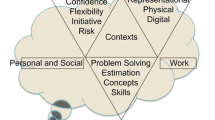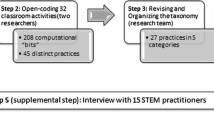Abstract
Our goal in this article is to organise an epistemological matrix for the concept of rational number that contemplates its different meanings. Aiming at understanding the various ways to signify the rational numbers and based on the theoretical-methodological approach of conceptual profiles, we produce and analyse data from various sources, including the sociocultural and ontogenetic domains, namely data extracted from secondary sources on the history of mathematics, mathematical analysis of subconstructs of rational numbers, analysis of textbooks for the middle and high school, as well as textbooks for higher education, research data on students’ alternative conceptions, interviews with 3 teacher educators and 4 in-service teachers from middle and high school. Such data allowed us, by means of an active interpretation of the researchers, to list 11 themes from which the rational numbers can be signified and to organise them into an epistemological matrix. Finally, we conduct a theoretical discussion that compares our epistemological matrix with an already quite widespread perspective in mathematics education, which is Kieren’s subconstructs.

Similar content being viewed by others
Notes
We choose to use and preserve the acronym of Epistemological Matrix of Rational Number as MENR, because it is referring to Matriz Epistemológica de Número Racional, in Portuguese.
A doctoral thesis (Angeli 1, 2017), held in Brazil, which had as main objective to investigate and propose theoretical-methodological foundations for teaching the field of rational numbers in Mathematics Teacher Education undergraduate courses.
For a more discussion about the concept of rate, we indicate Thompson (1994).
References
Angeli, M. (2014). Atribuição de significados ao conceito de variável: Um estudo de caso numa Licenciatura em Matemática [Attribution of meanings to the concept of variable: A case study in a mathematics degree] (Doctoral dissertation). Instituto Federal do Espírito Santo, Vitória, Brazil.
Bachelard, G. (1984). A filosofia do não [The philosophy of no]. In Coleção os Pensadores (pp. 1–87). São Paulo, Brazil: Abril Cultural.
Behr, M. J., Lesh, R., Post, T. R., & Silver, E. A. (1983). Rational numbers concepts. In R. Lesh & M. Landau (Eds.), Acquisition of mathematics concepts and processes (pp. 91–125). New York, NY: Academic.
Caraça, B. J. (1951). Conceitos fundamentais da matemática [Fundamental concepts of mathematics]. Lisboa, Portugal: Tipografia Matemática.
Carpenter, T. P., Fennema, E., & Romberg, T. A. (Eds.). (2009). Rational numbers: An integration of research. New York, NY: Routledge.
Carvalho, M. S., Lopes, M. L. M. L., & Souza, J. C. M. (1984). Fundamentação da matemática elementar [Grounds of elementary mathematics]. Rio de Janeiro, Brazil: Câmpus.
Chavante, E. R. (2015a). Convergências: Matemática, 6 °ano: Anos finais do Ensino fundamental [Convergences: Mathematics, 6th year: Middle school] (1st ed.). São Paulo, Brazil: Edições SM.
Chavante, E. R. (2015b). Convergências: Matemática, 7 °ano: Anos finais do Ensino fundamental [Convergences: Mathematics, 7th year: Middle school] (1st ed.). São Paulo, Brazil: Edições SM.
Chavante, E. R. (2015c). Convergências: Matemática, 8 °ano: Anos finais do Ensino fundamental [Convergences: Mathematics, 8th year: Middle school]. (1st ed.). São Paulo, Brazil: Edições SM.
Crotty, M. (1998). The foundations of social research: Meaning and perspective in the research process. London, England: SAGE.
Damico, A. (2007). Uma investigação sobre a formação inicial de professores de matemática para o ensino de números racionais no ensino fundamental [An investigation into the initial training of mathematics teachers for the teaching of rational numbers in primary education] (Doctoral dissertation). Pontifícia Universidade Católica de São Paulo, São Paulo, Brazil.
Domingues, H. H., & Iezzi, G. (2003). Álgebra moderna [Modern algebra] (4th ed.). São Paulo, Brazil: Atual.
Elias, H. R. (2017). Fundamentos teórico-metodológicos para o ensino do corpo dos números racionais na formação de professores de matemática [Theoretical-methodological framework for the teaching of the field of rational numbers in mathematics teacher education] (Doctoral dissertation). Universidade Estadual de Londrina, Londrina, Brazil.
Esteban, M. P. S. (2010). Pesquisa qualitativa em educação: Fundamentos e tradições [Qualitative research in education: Fundamentals and traditions]. Porto Alegre, Brazil: AMGH Editora Ltda.
Fávero, M. H. & Neves, R. S. P. (2012). A divisão e os racionais: Revisão bibliográfica e análise [The rational division and literature review and analysis]. Zetetiké, Campinas, 20(37).
Ifrah, G. (1996). Os números: História de uma grande invenção (8ª edição) [Numbers: History of a great invention (8th ed.)]. (S. M. de Freitas Senra, Trans.). São Paulo, Brazil: Globo.
Katz, V. J. (2010). História da matemática [History of mathematics]. Lisboa, Portugal: Fundação Calouste Gulbenkian.
Kieren, T. E. (1976). On the mathematical, cognitive, and instructional foundations of rational numbers. In R. Lesh (Ed.), Number and measurement: Papers from a research workshop (pp. 101–144). Columbus, OH: ERIC/SMEAC.
Kieren, T. E. (1980). The rational number construct—its elements and mechanisms. In T. Kieren (Ed.), Recent research on number learning (pp. 125–150). Columbus, OH: ERIC/SMEAC.
Kieren, T. E. (1988). Personal knowledge of rational numbers: Its intuitive and formal development. In J. Hiebert & M. Behr (Eds.), Number concepts and operations in the middle grades (pp. 162–181). Reston, VA: National Council of Teachers of Mathematics.
Kieren, T. E. (2009). Rational and fractional numbers: From quotient fields to recursive understanding. In T. P. Carpenter, E. Fennema, & T. A. Romberg (Eds.), Rational numbers: An integration of research (pp. 49–84). New York, NY: Routledge.
Machado, A. C. (1998). A aquisição do conceito de função: Perfil das imagens produzidas pelos alunos [The acquisition of the function concept: Profile of the images produced by the students] (Doctoral dissertation). Faculdade de Educação, Universidade Federal de Minas Gerais, Belo Horizonte, Brazil.
Moreira, P. C., & Ferreira, M. C. C. (2008). A Teoria dos Subconstrutos e o número racional como operador: Das estruturas algébricas às cognitivas [The theory of subconstructs and the rational number as operator: From algebraic to cognitive structures]. Bolema, Rio Claro, 21(31), 103–127.
Mortimer, E. F. (1994). Evolução do atomismo em sala de aula:Mudanças de perfis conceituais [Evolution of atomism in the classroom: Changes in conceptual profiles] (Doctoral dissertation). Universidade de São Paulo, São Paulo, Brazil.
Mortimer, E. F. (1995). Conceptual change or conceptual profile change? Science & Education, 4, 265–287.
Mortimer, E. F. (2000). Linguagem e formação de conceitos no ensino de ciências [Language and concept formation in science teaching]. Belo Horizonte, Brazil: UFMG.
Mortimer, E. F., Scott, P., & El-Hani, C. N. (2009). Bases teóricas e epistemológicas da abordagem dos perfis conceituais [Theoretical and epistemological grounds of the conceptual profile approach]. In Proceedings of Encontro Nacional de Pesquisa em Ensino de Ciências, VII (pp. 1–12). Florianópolis, Brazil: ABRAPEC.
Mortimer, E. F., Scott, P., Amaral, E. M. R., & El-Hani, C. N. (2014). Conceptual profiles: Theoretical-methodological bases of a research program. In E. F. Mortimer & C. N. El-Hani (Eds.), Conceptual profile: A theory of teaching and learning scientific concepts (pp. 3–33). New York, NY: Springer.
Niven, I. (1984). Números: Racionais e irracionais [Numbers: Rational and irrational]. Rio de Janeiro, Brazil: Sociedade Brasileira da Matemática.
Norton, A., & Wilkins, J. L. M. (2010). Students’ partitive reasoning. Journal of Mathematical Behavior, 29, 181–194.
Pinto, M. F. & Tall, D. (1996). Student teachers’ conceptions of the rational numbers. In L. Puig & A. Gutierrez (Eds.), Proceedings of the 20th Conference of the International Group for the Psychology of Mathematics Education (Vol. 4, pp.139-146), Valencia, Spain: Universitat de Valencia.
Ribeiro, A. J. (2013). Elaborando um perfil conceitual de equacao: Desdobramentos para o ensino e a aprendizagem de Matematica [Developing a conceptual profile of equation: Developments for the teaching and learning of Mathematics]. Ciencia e Educacao, Bauru, 19(1), 55–71.
Roque, T. (2012). História da matemática: Uma visão crítica, desfazendo mitos e lendas [History of mathematics: A critical view, undoing myths and legends]. Rio de Janeiro, Brazil: Zahar.
Sepulveda, C. (2010). Perfil conceitual de adaptação: Uma ferramenta para análise de discurso de salas de aula de biologia em contextos de ensino de evolução [Conceptual profile of adaptation: A tool for discourse analysis of biology classrooms in contexts of evolution teaching] (Doctoral dissertation). Universidade Federal da Bahia, Salvador.
Sepulveda, C., Mortimer, E. F., & El-Hani, C. N. (2013). Construção de um perfil conceitual de adaptação: Implicações metodológicas Para o programa de pesquisa sobre perfis conceituais e o ensino de evolução [The construction of a conceptual profile of adaptation: Methodological implications to the research program on conceptual profiles and to evolution teaching]. Investigações em Ensino de Ciências, Porto Alegre, 18(2), 439–479.
Sepulveda, C., Mortimer, E. F., & El-Hani, C. N. (2014). Conceptual profile of adaptation: A tool to investigate evolution learning in biology classrooms. In E. F. Mortimer & C. N. El-Hani (Eds.), Conceptual profile: A theory of teaching and learning scientific concepts (pp. 163–200). New York, NY: Springer.
Shahbari, & Peled. (2017). Modelling in primary school: Constructing conceptual models and making sense of fractions. International Journal of Science and Mathematics Education, 15(2), 371–391.
Steffe, L. P. (2002). A new hypothesis concerning children’s fractional knowledge. Journal of Mathematical Behavior, 20, 267–307.
Steffe, L. P., & Olive, J. (Eds.). (2010). Children’s fractional knowledge. New York, NY: Springer.
Thompson, P. W., & Saldanha, L. A. (2003). Fractions and multiplicative reasoning. In J. Kilpatrick, W. G. Martin, & D. Schifter (Eds.), Research companion to the principles and standards for school mathematics (pp. 95–113). Reston, VA: National Council of Teachers of Mathematics.
Thompson, P. W. (1994). The development of the concept of speed and its relationship to concepts of rate. In G. Harel & J. Confrey (Eds.), The development of multiplicative reasoning in the learning of mathematics (pp. 181–234). Albany, NY: SUNY Press.
Vygotsky, L. S. (2000). A construção do pensamento e da linguagem [The construction of thought and language] (P. Bezerra, Trans.). São Paulo, Brazil: Martins Fontes.
Wasserman, N. H. (2014). Introducing algebraic structures through solving equations: Vertical content knowledge for K-12 mathematics teachers, PRIMUS: Problems, Resources, and Issues in Mathematics Undergraduate Studies, 24(3), 191–214.
Author information
Authors and Affiliations
Corresponding author
Rights and permissions
About this article
Cite this article
Elias, H.R., Ribeiro, A.J. & Savioli, A.M.P.d. Epistemological Matrix of Rational Number: a Look at the Different Meanings of Rational Numbers. Int J of Sci and Math Educ 18, 357–376 (2020). https://doi.org/10.1007/s10763-019-09965-4
Received:
Accepted:
Published:
Issue Date:
DOI: https://doi.org/10.1007/s10763-019-09965-4




